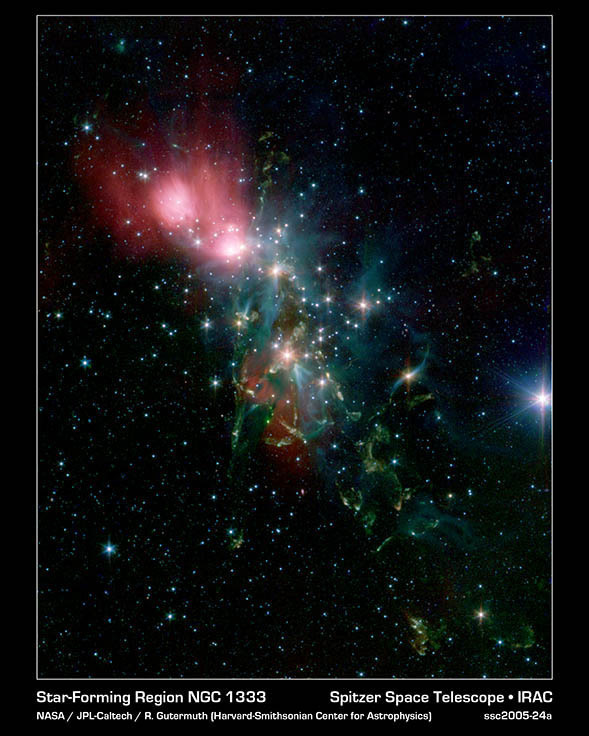MarkBour wrote: ↑Wed Mar 27, 2019 4:09 pm
As I read the caption today, I wondered what the two prominent stars were in the image, particularly the one at the center of the reflection region. I thought perhaps that was Algol. Dear fellow starship asterisk travellers, I'm wondering how you would go about answering such a question, and what tools you would use?
I tried playing around with SIMBAD. As I've noted, it's an amazing resource, but I surely could use some instruction in its proper use (and maybe an entire astronomy course to understand what it lists). I'm now guessing that the two stars in the image are not bright enough in Earth's skies to be famous and named. The best I can tell, the object at the center of the blue reflection nebula here is "BD +30 549" and rather than just calling it a star, they call it a "young stellar object". Algol is evidently quite far away from the field of view for today's APOD and is much brighter (viewed from Earth) than these objects.
I would, as always, use my software Guide.
Then I would click "n" for "NGC object" and fill in "1333". This would take me to NGC 1333. My software shows me a small nebula, and as I zoom in, I can see a tiny star inside the brightest part of the nebula. It is a faint 10th magnitude star, very faint. The graphics of the nebula provided by my software shows more stars in there, but only this one star is "clickable". I click it to find out more about the star.
I always check for an HD designation for every star I look up, but in this case there is none. The star does have a Hipparcos and a Tycho designation, HIP 16243 or TYC 2343 624. I use the Hipparcos designation to check the star in Simbad. According to Simbad, the star is indeed BD+30 549. Simbad described it as a "Young Stellar Object", which is certainly true. There is an accompanying DSS picture of the star, which shows it sitting in a blue reflection nebula. Check. The probable spectral class of BD+30 549 is given by Simbad as B8:p C ~. All I get out of that is that the star probably is of late spectral type B.
Simbad tells us several things about this star, like its coordinates. I always use the ICRS coordinates, because they are the ones I can use in my software to get to an object by filling in the right ascension and declination coordinates. The coordinates given for this star shows that it is in the northern hemisphere (because of the + sign in the declination). More specifically, the star is in Perseus, although close to the borders of Taurus and Aries. (And I figured that out by checking my software, not by computing the star's position from the coordinates in Simbad.)
The proper motion of a star indicates the intrinsic motion of the star, how it moves across the sky from our point of view. Check out
this 2 MB picture to see the proper motion of the famous double star 61 Cygni.
The radial velocity of a star is how it moves along our line of sight. (Or more specifically, I think it indicates if the star appears to move towards us or away from us, in relation to our own motion in our orbit around the Galaxy.)
The parallax of a star is how it appears to move "back and forth" as the Earth moves from one point in its orbit around the Sun to an "opposite point" six months later. Proxima Centauri, the most nearby star after the Sun, shows the largest parallax of all stars in the sky. Its parallax is 771.64 ± 2.60 milliarcseconds. This parallax is so large that we can say with confidence that Proxima Centauri is located 4.227 ± 0.014 light-years from us.
But BD+30 549? Its parallax is only 3.3836 [± 0.0831] milliarcseconds. I guess that is a Hubble or possibly Gaia parallax, because there is no way that Hipparcos could measure it so precisely. I leave it to you to figure out how far away that makes BD+30 549!
The "fluxes" shows how bright the star is in different wavelengths, from ultraviolet to infrared. The "magnitude" of a star, unless otherwise stated, usually refers to the star's V magnitude, its magnitude in yellow-green light.
So much for Simbad and BD+30 549. Finally I decided I would check out Algol, again by using my software Guide, by writing "Algol" in the "Object name" box. Algol is a second magnitude star, more than eight magnitudes brighter in the sky than BD+30 549. But lo and behold, Algol and BD+30 549 belong to (sort of) the same spectral class, at least: Both are B8-type stars.
But of course, Algol and BD+30 549 are very, very different stars, for all of that. Algol is the famous "Algol variable", where a main sequence star has stolen huge amounts of mass from its swollen companion. As a result, the secondary star has become the primary, a "blue straggler" in all its glory, while the red giant has shrunk to a pitiful remainder of its former ruby splendour.
Ann
 NGC 1333: Stellar Nursery in Perseus
NGC 1333: Stellar Nursery in Perseus
